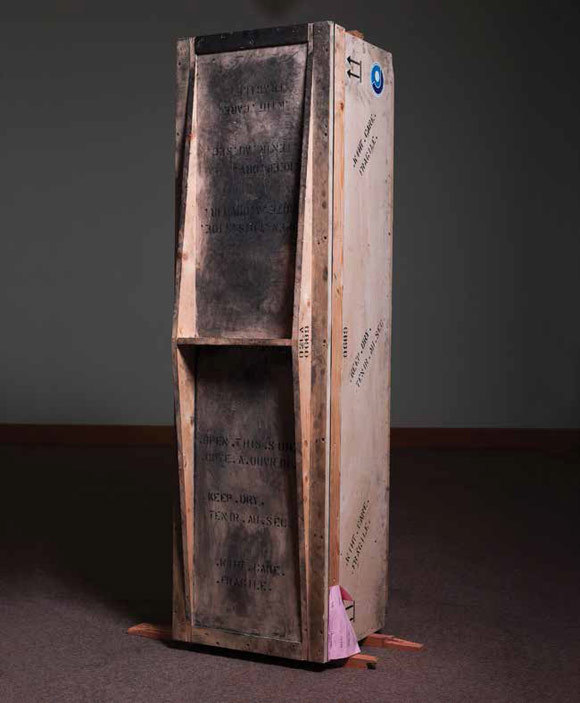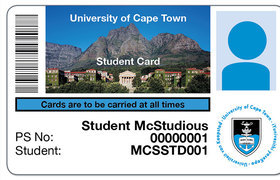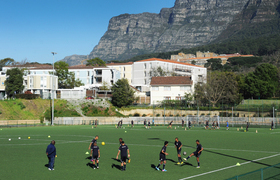The humility of Sarah Baartman
01 December 2014
Assoc Prof Nick Shepherd from the Centre for African Studies reflects on brief encounters with material objects - in this case, an empty box - and their effect on us.
This is the story of an empty box. It is also the story of a brief encounter with a material object, and the effects produced by that object in the moment of encounter. It concerns the afterlife of Sarah Baartman. Sarah 'Saartjie' Baartman was a Khoisan woman born in the vicinity of the Gamtoos River in what is now the Eastern Cape, South Africa, some time before 1790. Orphaned in a commando raid, she passed into the hands of Dutch farmers near Cape Town as a slave. In 1810 she was taken to London, where she was exhibited as a freak show attraction under the name of the 'Hottentot Venus'. Attention focused on her enlarged buttocks (steatopygia) and elongated labia minora, a purported feature of some Khoisan women that excited much speculation in early modern Europe. She was later sold and taken to France, where she was exhibited by an animal trainer, Regu, and was the subject of several 'scientific paintings'. Sarah Baartman died on 29 December 1815 of an inflammatory ailment, possibly smallpox. An autopsy was conducted and published by the French anatomist Henri Marie Ducrotay de Blainville, and republished by the naturalist Georges Cuvier. Her skeleton, preserved genitalia and brain were placed on display in the Musée de l'Homme in Paris, until they were removed from public view and stored in 1974. When the African National Congress came to power in South Africa in 1994, President Nelson Mandela formally requested the return of the remains of Sarah Baartman. After much legal wrangling in the French National Assembly, France acceded to the request on 6 March 2002. Her remains were repatriated, and on 9 August 2002 - National Women's Day in South Africa - reburied on Vergaderingskop, a hill outside the town of Hankey in the Eastern Cape.
Which is about as much as I, and most South Africans, know about Sarah Baartman, and as much as one can get from Wikipedia, the source for this account. The Wikipedia entry is itself based on a fine, recent biography of Sarah Baartman by Clifton Crais and Pamela Scully (2009). The entry concludes by noting that Sarah Baartman has become an icon in post-apartheid South Africa, "representative of many aspects of the nation's history". It does not list these aspects, but we might do so here: the genocide of the Cape San, racial slavery, extreme forms of objectification, the violence of colonial and imperial representational economies, the simultaneous sexualisation and degradation of black bodies, the twin poles of fear and desire around which colonialist discourse spins its accounts. And that should be that. The reburial of Sarah Baartman marks an ending, a closing of the circle. The formal environment of the graveside, in an appropriately inspirational setting, both directs our responses and contains the energies released by her life and melancholy afterlife. With a designated site in which to remember Sarah Baartman (we might say), we are free to forget her, which is how most shrines and memorials work in their particular relational economy of remembering and forgetting. Except that material worlds are messier, more difficult to contain, and the encounters that they enable are less predictable.
In March 2011, my cousin, Sven Ouzman, started a new job as curator of pre-colonial archaeology at the Iziko South African Museum in Cape Town. My friend, the Argentinian archaeologist Alejandro Haber, was visiting. We decided to drop in on Sven, who had promised us a tour of the archaeological stores. It was Sven's second or third day on the job, so there was something informal about the visit: we wanted to look around, but we also wanted to welcome him to his new appointment. The South African Museum is located in central Cape Town, in the old Dutch East India Company's Garden, close to parliament. It is one of a number of designated archaeological repositories and has about 10 000 boxes of material, of which about 1 000 are boxes of human remains. The archaeological store is split between two rooms, a main store that is on the same level as the staff offices, and a second store one floor up. We were to begin in the main store. You need to picture a long, low-ceilinged room, fluorescent lights, rows of shelves closely packed with cardboard boxes. Some staffers and visiting researchers joined our tour, so we were a small group that moved through the room, pausing here and there to look at objects in the collection.
From the start, you might say, this was a tour conducted on two levels. There was the official tour which was given by one of Sven's staffers, and which was filled with facts and figures. And then there was something else: an uncanny awareness of place, an uneasy awareness of the proximity of the massed human remains. Derrida (1994) writes of the haunting of the present by reminders of past injustice: 'spectres' in his terminology. Somehow the bright lights and neatly stacked shelves only served to underline the spectral nature of the store with its remains. So it proceeded. Every now and then we would encounter an oddity, something that did not fit into a box but had been consigned to the archaeological store. Some of these were life casts, made in the 1920s and 1930s by a museum staffer of persons described as 'Bushman' (or San). Painted in flesh tones, partly shrouded in white sheets, they added their own spectral presence to the scene. Rounding a corner in the rows of shelves we came across a tall wooden crate, about the dimensions of a human being. A shipping bill stuck to the side indicated that it had been sent to South Africa from France in 2002. Sven's staffer made the connection for us: we were looking at the crate in which Sarah Baartman had been repatriated.
This was the moment of encounter to which my story has been leading. The effect of the crate was extraordinary. For ten or fifteen minutes we just stood there. Some of us touched it: such a humble crate after all. All of our uneasy awareness of place, the proximity of the human remains and the violence of their wrenching from graves and sacred sites across the country, became focused on a single object. We were aware of a double or triple irony: while Sarah Baartman had been repatriated and reburied, the South African state has so far resisted calls for the repatriation of human remains in museum collections. There was also the fact that we were looking not at the remains of Sarah Baartman, but at the empty crate in which those remains had been returned. (Why had the crate been preserved? Is it normal practice to keep the crates in which museum objects are shipped?) After having to endure so much focused looking in life, such a harsh form of the gaze, it seemed right that the crate should be empty, that Sarah Baartman should be safely emplaced beyond reach. We talked of how the crate should be installed as the first object one encounters on entering the museum display, of how a postcolonial museum might take its logic from this single object, grow outwards from this single source.
The museum as institution arose in recognition of the power of material objects. At the same time, it presents these object within strict limits, contains their latent power by practices of labelling and the formal protocols of display. Part medieval reliquary, part scientific laboratory, the museum environment makes for a hybrid set of encounters. Every now and then it produces its own moment of rupture, as in the case of this story of an empty box.
References
- Sara Baartman and the Hottentot Venus by Clifton Crais and Pamela Scully (2009)
- Specters of Marx: the state of the debt, the work of mourning & the new international by Jacques Derrida (1994)
Read other essays in Stephen Inggs' Object Relations collection - about Virgina MacKenny contemplating the significance of a glass of water, Mark Solms' last letter from his father, Andy Buffler's plastic scintillator (which glows when exposed to radiation), what a tennis racket means to Hedley Twidle, or Nick Shepherd encountering the box in which Sarah Baartman's remains were repatriated.
 This work is licensed under a Creative Commons Attribution-NoDerivatives 4.0 International License.
This work is licensed under a Creative Commons Attribution-NoDerivatives 4.0 International License.
Please view the republishing articles page for more information.










